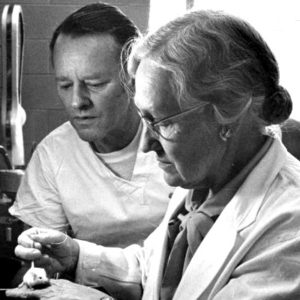calsfoundation@cals.org
Pertussis
aka: Whooping Cough
Pertussis or “whooping cough” is an acute infectious disease caused by the bacteria Bordetella pertussis. Person-to-person transmission occurs through respiratory droplets. Following an incubation period of seven to fourteen days, pertussis progresses through the catarrhal, paroxysmal, and convalescent stages. Cold-like symptoms—including a runny nose, sneezing, a mild cough, and a low-grade fever—characterize the catarrhal stage. The paroxysmal stage begins one or two weeks later and lasts for up to eight weeks. Patients suffer from numerous rapid bursts of productive coughing followed by a long, inspiratory whoop, which is the origin of the disease’s common name. Young infants may exhibit breathing difficulties instead of whooping. Coughing spasms produce vomiting and cyanosis. Gradual recovery characterizes the convalescent stage. Neither vaccination nor recovery confers lifelong immunity.
Fully vaccinated adults and adolescents are less likely to develop severe disease and may be asymptomatic. Complications such as pneumonia, fainting, and coughing-related rib fracture can develop in adults and teens. The highest risk of hospitalization and death due to pertussis-related complications (such as pneumonia and apnea) occurs in unvaccinated or incompletely vaccinated infants who are under six months old.
In the seventh century, the Chinese physician Yuanfang Chao described a pertussis-like illness. In 1578, the French physician Guillaume de Baillou recorded an early description of whooping cough. In 1679, the British physician Thomas Sydenham named the disease pertussis, deriving the name from the Latin words meaning “intense cough.”
In the nineteenth century, whooping cough was a common and often fatal childhood illness, but its epidemiology is unclear. Collection of data was poor in the absence of reliable and accurate diagnostic testing and a lack of consistent patient access to physicians, especially for those living in rural areas. In the United States, pertussis became a reportable disease in 1922. In that year, Arkansas reported 371 cases of whooping cough and fifty-two deaths.
In 1906, the Belgian bacteriologists Jules Bordet and Octave Gengou isolated the pertussis bacillus. In the 1920s and 1930s, Danish and American medical researchers tested whole-cell pertussis vaccines in patients. In the early 1940s, Prairie Grove (Washington County) native Margaret Pittman, a bacteriologist at the National Institutes of Health, developed a potency test for the pertussis vaccine.
Following the introduction of the DPT vaccine (combined diphtheria, pertussis, tetanus) in 1948, the number of reported cases of pertussis in the United States fell from 265,269 in 1934 to 32,148 in 1958. In Arkansas, reported cases of the disease dropped from 806 in 1929 to 156 cases in 1958.
Arkansas’s vaccination law of 1967 mandated receipt of DPT and other childhood vaccinations for school entry. In 1971, Arkansas recorded fifty-one cases of whooping cough. In 1972, the Arkansas Department of Health reported that the immunization of schoolchildren had “[helped] reduce the incidence [of pertussis],” and emphasized the importance of pertussis vaccines for preschoolers. In 1973, Arkansas first lady Betty Bumpers’s “Every Child by ’74” vaccination campaign began.
During the 1980s and 1990s, however, the number of reported cases of pertussis in the United States increased after falling to a historic low of 1,010 cases in 1976. Medical experts attributed the rise in reported cases to increased awareness of the disease and improved diagnostic testing (rather than there necessarily being a spike in people falling ill).
Simultaneously, concerns grew about the reactogenicity of the whole-cell pertussis component in DPT. Injection site reactions and fever were common; seizures and other systemic events also occurred but more rarely. Studies showed that DPT did not, as some claimed, cause permanent brain damage in children. In 1997, the less reactogenic DTaP vaccine (combined diphtheria, tetanus, acellular pertussis) replaced DPT.
Between 1990 and 1994, Arkansas recorded 109 pediatric cases of pertussis and one death. In 1998, the state recorded 93 cases of whooping cough and no deaths.
From August 2001 through June 2002, Arkansas endured its largest outbreak of pertussis in the vaccine era, reporting 1,053 cases of the disease in fifty counties. Pulaski, Saline, Arkansas, Pike, and Lonoke counties recorded the highest numbers of cases. In early October 2001, state health department officials confirmed fifty cases in Murfreesboro High School in Pike County. By late October 2001, 102 cases had been confirmed in Pike County, and thirty-six cases confirmed in Pulaski County. State officials implemented surveillance and isolation for patients and their contacts, use of prophylactic antibiotics for all contacts, and immunizations for infants and children, which included starting infant vaccinations at six weeks of age instead of the usual two months. (The lower-dose Tdap vaccine for adults and teens did not become available until 2006.) No deaths were reported from this outbreak. The outbreak was not blamed on inadequate vaccination; rather, it was attributed to heightened awareness of the disease, improved diagnostic testing, waning immunity, and asymptomatic transmission.
Since 2012, the number of reported cases of pertussis in the state have remained low to moderate. In 2021, Arkansas recorded only thirteen cases of the disease.
Current vaccination schedules from the Centers for Disease Control and Prevention (CDC) recommend a five-dose series of DTaP for children and a Tdap booster every ten years for adults. To protect themselves and their newborns, women should receive Tdap either during pregnancy or immediately postpartum. In the twenty-first century, controlling whooping cough remains an ongoing medical challenge.
For additional information:
“20,185 Cases of Influenza in 1929.” Arkansas Gazette, February 4, 1930, p. 11.
“1958 Was Year for Measles.” Arkansas Democrat, July 19, 1959, p. 11A.
Arkansas Department of Health. “Immunizations.” https://www.healthy.arkansas.gov/programs-services/topics/immunizations (accessed February 3, 2024).
Centers for Disease Control and Prevention. “Pertussis Cases by Year (1922–2019).” https://www.cdc.gov/pertussis/surv-reporting/cases-by-year.html (accessed February 3, 2024).
Cherry, James D. “The History of Pertussis (Whooping Cough); 1906–2015: Facts, Myths, and Misconceptions.” Current Epidemiology Reports 2 (2015): 120–130.
Golden, Alex. “Warning Issued after Pertussis Diagnosis.” Arkansas Democrat-Gazette, April 5, 2019, p. 8B. Online at https://www.arkansasonline.com/news/2019/apr/05/warning-issued-after-pertussis-diagnosi/ (accessed February 3, 2024).
Havers, Fiona P., Pedro L. Moro, Susan Hariri, and Tami Skoff. “Centers for Disease Control and Prevention Pink Book Chapter 16: Pertussis.” http://www.cdc.gov/vaccines/pubs/pinkbook/downloads/pert.pdf (accessed February 3, 2024).
Kilgore, Paul E., Abdulbaset M. Salim, Marcus J. Zervos, and Heinz-Josef Schmitt. “Pertussis: Microbiology, Disease, Treatment, and Prevention.” Clinical Microbiology Reviews 29 (July 2016): 449–486.
Klein, Nicola P. “Licensed Pertussis Vaccines in the United States: History and Current State.” Human Vaccines and Immunotherapeutics 10 (September 2014): 2684–2690.
“Measles Cases in Arkansas Rise Sharply.” Arkansas Gazette, May 7, 1972, p. 23A.
Schutze, Gordon E., E. Lu, and S. Kirby. “Pertussis in Arkansas.” Journal of the Arkansas Medical Society 92 (May 1996): 623–626.
Scholle, Sarah Hudson. The Pain in Prevention: A History of Public Health in Arkansas. Little Rock: Arkansas Department of Health, 1990.
Wheeler, J. Gary, Tracy C. Tran, Paula North, Toni Beavers-May, Gordon E. Schutze and Sandra E. Snow. “Barriers to Public Health Management of a Pertussis Outbreak in Arkansas.” Archives of Pediatric and Adolescent Medicine 158 (February 2004): 146–152.
Yee, Daniel. “Whooping Cough Affects 1,053: State’s Outbreak Among Nation’s Highest, Despite Vaccinations.” Arkansas Democrat-Gazette (May 1, 2002), pp. 1B, 5B.
———. “Whooping Cough Cases Rise to 178 in State.” Arkansas Democrat-Gazette, October 25, 2001, p.2B.
———. “Whooping Cough Strikes about 50 Murfreesboro Pupils.” Arkansas Democrat-Gazette, October 4, 2001, pp. 1B, 10B.
Melanie K. Welch
Mayflower, Arkansas
 Health and Medicine
Health and Medicine Margaret Pittman
Margaret Pittman 




Comments
No comments on this entry yet.